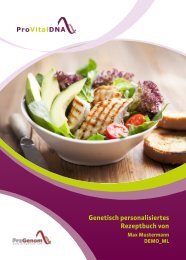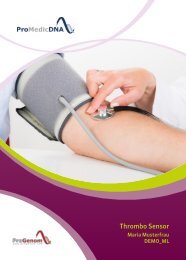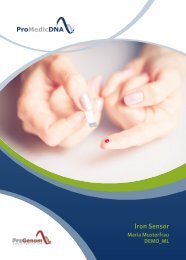ProVitalDNA - Package - DEMO EN
non-medical analysis - ProVitalDNA
non-medical analysis - ProVitalDNA
Create successful ePaper yourself
Turn your PDF publications into a flip-book with our unique Google optimized e-Paper software.
CALORIES<br />
Ideal calorie distribution<br />
Calories are the fuel for our cells and for athletic performance, and they are mainly obtained<br />
from the macronutrients fat, carbohydrates and protein. During the resting phase, the body<br />
gains from carbohydrates (glucose) and fat (triglycerides), roughly in equal proportions. Only<br />
when a great lack of energy occurs, the body starts to consume proteins from the muscles<br />
break down, in order to produce energy; this should, of course, be avoided in competitive<br />
sports. Additionally, the shape of the muscle plays a crucial role. As previously stated in this<br />
report, the ACTN3 gene controls the ratio between the white and the red muscle fibers, which<br />
burn different nutrients in order to produce energy. The amount of fat and carbohydrates<br />
needed during exercise thus depends on the nature (strength/endurance/mixture) and extent<br />
(short/long) of the activity.<br />
Energy balance during power sports<br />
The white muscle fibers are used when in power and speed sports. These activities use energy<br />
stored in the muscle, without oxygen, to power the muscles (the so-called anaerobic area).<br />
After about 20 seconds to 8 minutes without oxygen, this energy decreases, and the muscle<br />
fibers begin to convert carbohydrates into energy. More oxygen is thus needed, which is why<br />
breathing becomes faster. This form of energy consumes the stored carbohydrates (glycogen),<br />
which also gets depleted after a long period exercising. After exercising, the carbohydrate<br />
storage refill. For power sports the white muscle fibers are the main ones, and carbohydrates<br />
are exclusively used. For this reason, this type of physical activity requires a high-carbohydrate<br />
diet.<br />
Energy balance during endurance sports<br />
In case of mild exercise the red muscle fibers are mainly used. In comparison to the white<br />
muscle fiber, the energy is obtained not only from carbohydrates, but also from fat. This<br />
process yields about 3 times more energy than the production from carbohydrates, but it<br />
requires significantly more oxygen and is limited by respiration. In this form of exercise the<br />
carbohydrate stores (Glycogen) remain in majority untouched and are available for short<br />
sprints available.<br />
Endurance athletes therefore use, as opposed to the strength athletes, not only<br />
carbohydrates, but also fat. For this reason, the supply of the right amounts of fat and<br />
carbohydrates for endurance athletes is of great importance.<br />
Energy balance during play sports<br />
Playing sports are usually a mixture of endurance sports, which is maintained throughout the<br />
game, and weight training, with short sprints and high efforts. For this reason, the red muscle<br />
fat and carbohydrates are mostly used, while the carbohydrate stores remain in the muscles.<br />
<strong>DEMO</strong>_ML Page 172 of 295


















